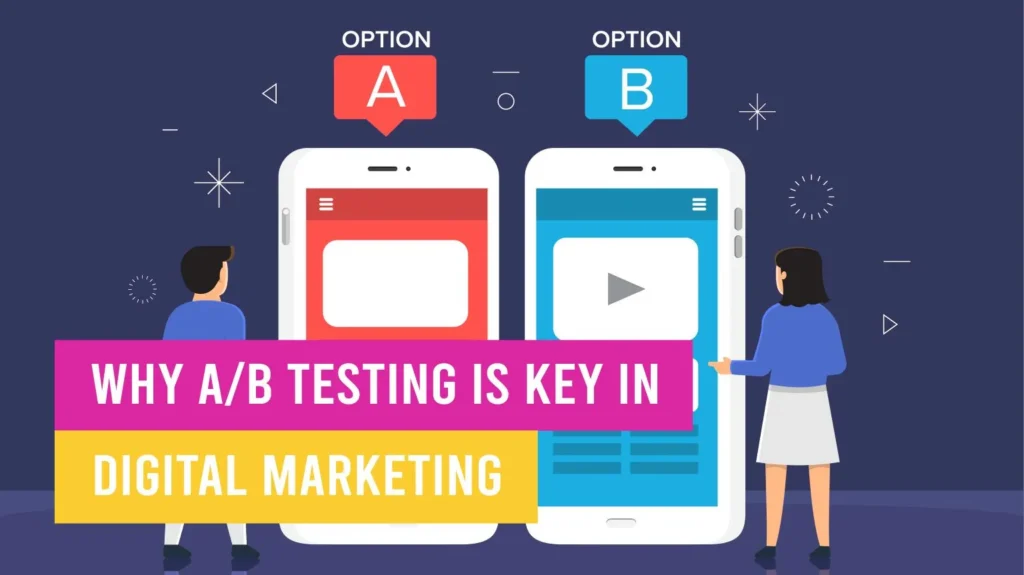Table of Contents
ToggleThe Importance of A/B Testing in Digital Marketing
Are you a digital marketer who is tired of guessing what your audience wants? Or a student trying to study the performance? If so, let me share with you the importance of A/B testing in digital marketing and how it plays a role in solving your problem because you can’t always gamble with your marketing by just guessing or relying on intuition. Imagine being able to analyse and study your audience by comparing two different platforms and understanding what they want more. That’s where A/B testing comes in. It helps you analyse two different campaigns and compare them to see which performed better. In short, it helps you get a handle on your marketing and targeting. Let me share how this tool works and helps from understanding its fundamentals to exploring advanced techniques for personalisation and risk management.What is A/B testing?
A/B testing, also known as split testing, is a methodology used in digital marketing to compare two versions of a webpage, email, or other marketing asset to determine which one performs better. It works by exposing two different variants, A and B, to similar audiences and analysing which one shows better performance, brings higher conversion rates, or achieves the desired goal.Benefits for marketers and business
The benefits of A/B testing in digital marketing are numerous.- Better decision making ,
- High conversion rates,
- Enhanced user experience,
- Less bounce rate.
- Data-driven decisions – More statistical evidence reduces guesswork, leading to reduced risks and more accurate decision making,
- Cost-effective – This helps to optimise existing content without additional spending,
- Constant Optimisation – Allows for steady improvements over time.
Application in Digital Marketing
 A/B testing can be applied to various elements of digital marketing:
A/B testing can be applied to various elements of digital marketing:
- Ad copy and images
- Website design and layout
- Call to action buttons
- Email subject lines and content
- Pricing strategies
- Landing page elements
Key Components of A/B testing
Effective A/B testing consists of many elements, which explain the need to conduct the test to compare two versions of something. The importance of A/B testing in digital marketing lies in its ability to optimise strategies based on data driven insights.- Control and Variant – The control will be the original version ‘A’ that serves as the base for the comparison. The variant will be the modified version ‘B’ that you want to test to see if it performs better than the control.
- Hypothesis – A clear prediction of how the change will impact performance. For example, you might think one group will respond better to a specific cultural reference or design style than the other.
- Sample size – A statistically significant number of participants. If the sample size is bigger, the results might accurately reflect the true performance of the variant.
- Duration – Sufficient time to gather meaningful data. The test should run long enough to make an effective decision. Running the test too briefly might lead to inconclusive or misleading results.
- Metrics – These are specific key performance indicators needed to measure the performance. These particular measurements you’ll use to determine if the variant is better than the control. Focus on particular measurements, like click-through rates or engagement levels, to see which version works better with each demographic.
Maximising Conversion Rates
Now that you have an idea about the elements involved in A/B testing, let’s see how it could be used to maximise conversion rates. By applying these elements, you can effectively compare different versions to determine which one drives better results, ultimately increasing your conversion rate. Enhancing Social Media Ad Performance – A/B testing helps in optimising social media and campaigns. By experimenting with various elements like ad copy, images, and targeting options, marketers can identify the most effective combinations that resonate with their audience. This process will eventually help in leading to a significant improvement in return on ad spend (ROAS).
Improving Email Marketing Campaigns – Email marketing is one of the powerful tools for enhancing your marketing strategy. And A/B testing can help refine every aspect of your campaigns including, the subject lines, email content, call-to-action buttons, and send times.
Optimising Landing pages and CTAs – Landing pages are often the final step in the conversion funnel. A/B testing can help identify the most effective page layouts, headline variations, form design, CTA button colours, and texts.
Creating Effective Test Hypotheses – To maximise the impact of A/B testing, it’s essential to formulate clear and provable hypotheses. Here’s a simple framework:
Enhancing Social Media Ad Performance – A/B testing helps in optimising social media and campaigns. By experimenting with various elements like ad copy, images, and targeting options, marketers can identify the most effective combinations that resonate with their audience. This process will eventually help in leading to a significant improvement in return on ad spend (ROAS).
Improving Email Marketing Campaigns – Email marketing is one of the powerful tools for enhancing your marketing strategy. And A/B testing can help refine every aspect of your campaigns including, the subject lines, email content, call-to-action buttons, and send times.
Optimising Landing pages and CTAs – Landing pages are often the final step in the conversion funnel. A/B testing can help identify the most effective page layouts, headline variations, form design, CTA button colours, and texts.
Creating Effective Test Hypotheses – To maximise the impact of A/B testing, it’s essential to formulate clear and provable hypotheses. Here’s a simple framework:
- Component – Identify and fix the specific element you are testing.
- If we – Describe the change: Clearly state what change you are implementing. Then – Predict the outcome: Explain what you expect to happen as a result of the change.
- Because – Explain the rationale: Provide the reasoning behind your prediction.
- Component: CTA button colour.
- If we – Change the CTA button colour from red to green.
- Then – We expect to see a higher click-through rate.
- Because – Green is often perceived as more inviting and can attract more attention compared to red, leading to increased clicks.
Data-Driven Decision Making
A/B testing plays a crucial role in promoting data-driven decision making. It helps you make appropriate decisions based on proven data rather than on guesswork. Distributing Resources Efficiently – A/B testing helps marketers allocate resources more effectively by identifying high-performing campaigns, excluding underperforming strategies, and optimising budget distribution. Without A/B testing, resource allocation is often low in accuracy, potentially wasteful, and unpredictable. In contrast, A/B testing enhances accuracy by relying on data, optimises resource use, and improves ROI.
Reducing Guesswork in Marketing Strategies – By leveraging A/B testing, marketers can test multiple variations of content, designs, or campaigns, identify which elements resonate best with the target audience, and make informed decisions based on statistical significance.
Gathering Actionable Insights – A/B testing provides a wealth of actionable insights that can inform future marketing efforts user behaviour patterns, preferences across different demographics, and performance metrics for various marketing elements.
These not only create an immediate impact but, with strategic moves, also contribute to long term effectiveness and sustained results.
Distributing Resources Efficiently – A/B testing helps marketers allocate resources more effectively by identifying high-performing campaigns, excluding underperforming strategies, and optimising budget distribution. Without A/B testing, resource allocation is often low in accuracy, potentially wasteful, and unpredictable. In contrast, A/B testing enhances accuracy by relying on data, optimises resource use, and improves ROI.
Reducing Guesswork in Marketing Strategies – By leveraging A/B testing, marketers can test multiple variations of content, designs, or campaigns, identify which elements resonate best with the target audience, and make informed decisions based on statistical significance.
Gathering Actionable Insights – A/B testing provides a wealth of actionable insights that can inform future marketing efforts user behaviour patterns, preferences across different demographics, and performance metrics for various marketing elements.
These not only create an immediate impact but, with strategic moves, also contribute to long term effectiveness and sustained results.
Personalisation and User Experience in A/B Testing
Okay! Now that we understand the importance of data driven decision making, let’s explore some of the benefits of A/B testing in digital marketing. Modifying content to audience preferences – A/B testing helps in optimising content to better match your audience’s preferences. By presenting different versions of content to various segments of your audience, you can identify which elements resonate best with specific groups. This method is crucial in understanding the importance of A/B testing in digital marketing. It helps in highly personalising and targeting the audience. Customising content provides several benefits. Firstly, it increases engagement because personalised content captures the audience’s attention more effectively. Secondly, it leads to higher conversion rates, as personalised messaging improves the chances of conversions. Additionally, tailored content enhances brand loyalty since customers appreciate content that addresses their specific needs. Lastly, it results in better ROI, with targeted campaigns yielding higher returns on marketing investment.
Enhancing customer satisfaction – By testing different elements of your digital marketing strategy, you can identify pain points in the customer journey, optimise email subject lines for better open rates, refine call-to-action buttons for increased clicks, and improve product descriptions to meet customer expectations.
Optimising user interfaces – A/B testing is great for optimising UI. You can test, button placements and colours, navigation menu structures, form layouts, and input fields, page load times, and performance.
These are some of the benefits of A/B testing in user experience for an audience. Now let’s explore some other aspects.
Modifying content to audience preferences – A/B testing helps in optimising content to better match your audience’s preferences. By presenting different versions of content to various segments of your audience, you can identify which elements resonate best with specific groups. This method is crucial in understanding the importance of A/B testing in digital marketing. It helps in highly personalising and targeting the audience. Customising content provides several benefits. Firstly, it increases engagement because personalised content captures the audience’s attention more effectively. Secondly, it leads to higher conversion rates, as personalised messaging improves the chances of conversions. Additionally, tailored content enhances brand loyalty since customers appreciate content that addresses their specific needs. Lastly, it results in better ROI, with targeted campaigns yielding higher returns on marketing investment.
Enhancing customer satisfaction – By testing different elements of your digital marketing strategy, you can identify pain points in the customer journey, optimise email subject lines for better open rates, refine call-to-action buttons for increased clicks, and improve product descriptions to meet customer expectations.
Optimising user interfaces – A/B testing is great for optimising UI. You can test, button placements and colours, navigation menu structures, form layouts, and input fields, page load times, and performance.
These are some of the benefits of A/B testing in user experience for an audience. Now let’s explore some other aspects.
Reducing Risks in Marketing Campaigns
In the growing landscape of digital marketing, mitigating risks is important for ensuring campaign success. The benefits of A/B testing in digital marketing include increased engagement, higher conversion rates, enhanced personalisation, and improved ROI, all of which help in minimising potential pitfalls and optimising marketing efforts. Let’s explore how A/B testing helps in risk mitigation across various aspects of marketing campaigns. Adapting to Changing Market Trends – Market trends are swiftly evolving, and keeping up with them is the only way to stay ahead. By experimenting strategically with campaign elements, businesses can identify emerging preferences, refine messaging to resonate with current audience sentiments, and adjust strategies in real time to maintain relevance.
Controlling Financial Loss – One of the most significant benefits of A/B testing in digital marketing is its ability to reduce financial risks. Here’s how it helps, small-scale testing before full deployment, identifying underperforming elements beforehand, and optimising budget allocation based on performance data. With A/B testing, you can invest gradually, lower risks with ongoing improvements, and gain clear insights into performance problems.
Trying out New Ideas Before Actual Implementation – New ideas are always great for a business, but they can also be risky. A/B testing provides a safe environment to experiment with these risks by validating creative concepts with a subset of the audience, gathering data on user preferences, and reshaping ideas based on real-world feedback.
Adapting to Changing Market Trends – Market trends are swiftly evolving, and keeping up with them is the only way to stay ahead. By experimenting strategically with campaign elements, businesses can identify emerging preferences, refine messaging to resonate with current audience sentiments, and adjust strategies in real time to maintain relevance.
Controlling Financial Loss – One of the most significant benefits of A/B testing in digital marketing is its ability to reduce financial risks. Here’s how it helps, small-scale testing before full deployment, identifying underperforming elements beforehand, and optimising budget allocation based on performance data. With A/B testing, you can invest gradually, lower risks with ongoing improvements, and gain clear insights into performance problems.
Trying out New Ideas Before Actual Implementation – New ideas are always great for a business, but they can also be risky. A/B testing provides a safe environment to experiment with these risks by validating creative concepts with a subset of the audience, gathering data on user preferences, and reshaping ideas based on real-world feedback.
Tools and Technologies for A/B Testing
Having explored various aspects of the importance of A/B testing in digital marketing, let’s have a look at the tools and technologies that help with A/B testing. AI-powered testing solutions – AI is the new trend. Utilising these tools with A/B testing offers advanced capabilities, including a predictive performance for test outcomes, automated audience distribution, and real time optimisation of test variables. Thus, this helps to reduce the number of people involved and the time needed. Integration with analytics tools – Integration with analytics platforms such as Google Analytics, Adobe Analytics, and Mixpanel can enhance performance. These integrations allow marketers to track user behaviour across multiple touchpoints, analyse test results in the context of wide user data, and create custom reports for stakeholders. These tools not only help in creating better strategies but also improve the overall user experience by leveraging the benefits of A/B testing in digital marketing. Popular A/B Testing Platforms –- Optimizely – Features include a visual editor, and multivariate testing and are best for Enterprise-level testing.
- VWO – Features include heatmaps, personalisation and are best for Mid-size businesses.
- Google Optimize – Features include integration with Google Analytics and best for small to medium businesses,
- AB Tasty – Features include AI-powered insights, cross-device testing, and best for e-commerce websites.
Best Practices for Effective A/B Testing
Some of the best practices and benefits of A/B testing in digital marketing include:
- Interpreting and applying test results.
- Avoiding common pitfalls.
- Determining sample size and test duration.
- Setting clear goals and metrics.

